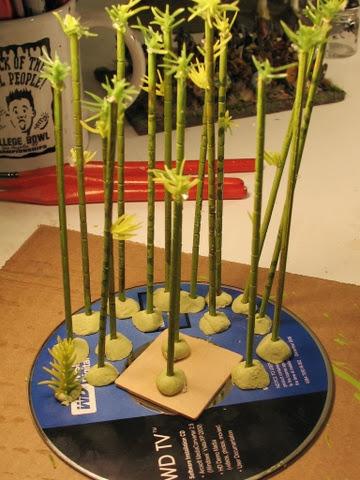The origins of Japan's warrior monks start with the relocation of the imperial capital from Nara to Heian in the late eighth century. Disputes broke out between monks from the two cities over issues of imperial favoritism and patronage. In 949, violent conflict, on the level of street brawls and skirmishing erupted between rival orders. As central authority declined in the eleventh and twelfth century, battles between the rival temples became larger in scale, and the Nara monastary fielded an army of over 3,000 Sohei. In the Gempei Wars of the 1180s, the Nara monks sided with the Minamoto clan. Their rivals, the Taira, so decisively destroyed the monks and their temple, that most Sohei stayed out of the remainder of the wars.
My Sohei buntai is mostly from The Assault Group, one of the few companies making models for the early Samurai period. As always, their figures are truly a joy to paint. Details are vivid, but not exaggerated. The fabric on the robes is natural and shows off shading and highlighting. I wish my painting did it better justice.
Not a lot of posing variance on the archers, but for a small warband, a shooting stance is what I want.
The unarmed monk is center is something I have had since the early 90s, and recently repainted. He can fit in as a Shugyosha. Can anybody ID its manufacturer?
Reading Background:
Japanese Warrior Monks AD 949-1603, by Stephen Turnbull and illustrated by Wayne Reynold. Stephen Turnbull is Osprey's go-to-guy for ancient and medieval Asian history and this is essential if one wants to learn the history, motivation and equipment of the Sohei. Reynold's illustrations are very good with bold line work and nice color contrasts.
Japanese Fortified Temples and Monastaries AD 720-1062. Fortress Monasteries. by Stephen Turnbull and illustrated by Peter Dennis. Across his numerous Osprey titles, Turnbull can be a bit redundant. If one has the previous volume, Fortified Temples is probably non-essential. Its focus on fortress monasteries has some potential for those wanting to build their own terrain. Most of the illustrations are architectural in nature, but a couple of Dennis' plates are battle scenes. They lack the scope and impact of Wayne Reynolds, but are still useful for the painter needing reference. I also wonder if the title is in error, because the bulk of the material and illustrations deal with fighting monks and their castles well into the fifteenth and sixteenth centuries.
The Dragon Scroll, I.J. Parker. In this Heian-era mystery, a young Japanese bureaucrat's investigation of tax irregularities in a province lead him to a nearby temple whose members have been instigating violence in the nearby village. The lead character in the series, Akitada, is continually skeptic of Buddhism - or more likely distrustful of the degree to which the monasteries insinuated themselves into the corridors of power.

















